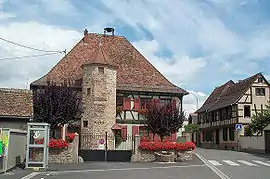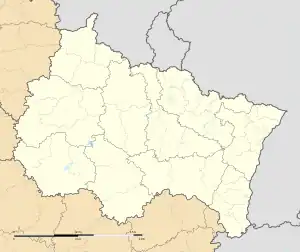Niedernai | |
|---|---|
 The town hall in Niedernai | |
.svg.png.webp) Coat of arms | |
Location of Niedernai | |
 Niedernai  Niedernai | |
| Coordinates: 48°26′54″N 7°31′01″E / 48.4483°N 7.5169°E | |
| Country | France |
| Region | Grand Est |
| Department | Bas-Rhin |
| Arrondissement | Sélestat-Erstein |
| Canton | Obernai |
| Intercommunality | Pays de Sainte-Odile |
| Government | |
| • Mayor (2020–2026) | Valérie Ruscher[1] |
| Area 1 | 11.33 km2 (4.37 sq mi) |
| Population | 1,253 |
| • Density | 110/km2 (290/sq mi) |
| Time zone | UTC+01:00 (CET) |
| • Summer (DST) | UTC+02:00 (CEST) |
| INSEE/Postal code | 67329 /67210 |
| Elevation | 152–182 m (499–597 ft) |
| 1 French Land Register data, which excludes lakes, ponds, glaciers > 1 km2 (0.386 sq mi or 247 acres) and river estuaries. | |
Niedernai (German: Niederehnheim) is a commune in the Bas-Rhin department in Alsace in north-eastern France.[3] It is located 26km south west of Strasbourg, 23km north of Sélestat and 50km north of Colmar on the main A35 road.
Niedernai dates back to pre-Roman times. In 707, it was part of the lands of the Feldkirch monastery, founded by the Benedictine monks of Moyenmoutier. From 1284, it was the seat of the Landsberg family, who built a fortified castle. The remnants of the castle can be seen in the "Glockenturm" watchtower.
The former Sainte Barbe church dates from 1741. By the 1850s it was too small for the congregation, so plans were begun for a new church. The parish church of Saint Maximin was built between 1891 and 1893. The former Sainte Barbe church is now a school. [4]
Niedernai is characterised by traditional wood-framed houses.
See also
References
- ↑ "Répertoire national des élus: les maires". data.gouv.fr, Plateforme ouverte des données publiques françaises (in French). 9 August 2021.
- ↑ "Populations légales 2021". The National Institute of Statistics and Economic Studies. 28 December 2023.
- ↑ INSEE commune file
- ↑ "Histoire [French]". Commune de Niedernai.